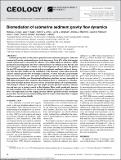Biomediation of submarine sediment gravity flow dynamics
Abstract
Sediment gravity flows are the primary process by which sediment and organic carbon are transported from the continental margin to the deep ocean. Up to 40% of the total marine organic carbon pool is represented by cohesive extracellular polymeric substances (EPS) produced by microorganisms. The effect of these polymers on sediment gravity flows has not been investigated, despite the economic and societal importance of these flows. We present the first EPS concentrations measured in deep-sea sediment, combined with novel laboratory data that offer insights into the modulation of the dynamics of clay-laden, physically cohesive sediment gravity flows by biological cohesion. We show that EPS can profoundly affect the character, evolution, and runout of sediment gravity flows and are as prevalent in deep oceans as in shallow seas. Transitional and laminar plug flows are more susceptible to EPS-induced changes in flow properties than turbulent flows. At relatively low concentrations, EPS markedly decrease the head velocity and runout distance of transitional flows. This biological cohesion is greater, per unit weight, than the physical cohesion of cohesive clay and may exert a stronger control on flow behavior. These results significantly improve our understanding of the effects of an unrealized biological component of sediment gravity flows. The implications are wide ranging and may influence predictive models of sediment gravity flows and advance our understanding about the ways in which these flows transport and bury organic carbon globally.
Citation
Craig , M J , Baas , J H , Amos , K J , Strachan , L J , Manning , A J , Paterson , D M , Hope , J A , Nodder , S D & Baker , M L 2020 , ' Biomediation of submarine sediment gravity flow dynamics ' , Geology , vol. 48 , no. 1 , pp. 72-76 . https://doi.org/10.1130/G46837.1
Publication
Geology
Status
Peer reviewed
ISSN
0091-7613Type
Journal article
Description
Funding: The Australian Government Research Training Program Scholarship funded Craig’s Ph.D. candidature. An International Association of Sedimentologists Postgraduate Award Grant funded Craig’s visit to Bangor University (Bangor, UK). The UK Natural Environment Research Council grant NE/1027223/1 (COHBED project) enabled this research to be undertaken using the flume facility built by Rob Evans (Bangor University).Collections
Items in the St Andrews Research Repository are protected by copyright, with all rights reserved, unless otherwise indicated.

